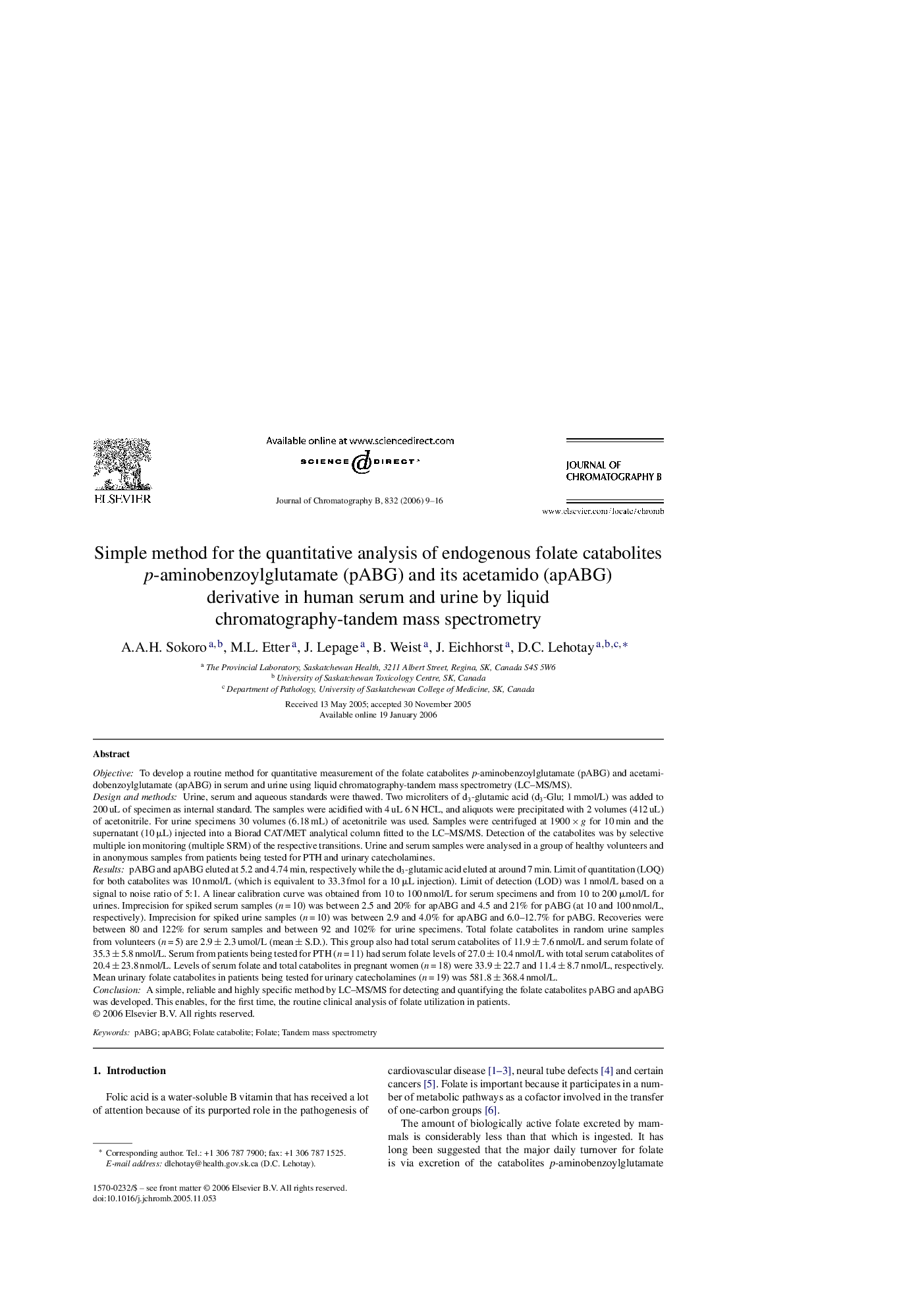| کد مقاله | کد نشریه | سال انتشار | مقاله انگلیسی | نسخه تمام متن |
|---|---|---|---|---|
| 1217978 | 967182 | 2006 | 8 صفحه PDF | دانلود رایگان |

ObjectiveTo develop a routine method for quantitative measurement of the folate catabolites p-aminobenzoylglutamate (pABG) and acetamidobenzoylglutamate (apABG) in serum and urine using liquid chromatography-tandem mass spectrometry (LC–MS/MS).Design and methodsUrine, serum and aqueous standards were thawed. Two microliters of d3-glutamic acid (d3-Glu; 1 mmol/L) was added to 200 uL of specimen as internal standard. The samples were acidified with 4 uL 6 N HCL, and aliquots were precipitated with 2 volumes (412 uL) of acetonitrile. For urine specimens 30 volumes (6.18 mL) of acetonitrile was used. Samples were centrifuged at 1900 × g for 10 min and the supernatant (10 μL) injected into a Biorad CAT/MET analytical column fitted to the LC–MS/MS. Detection of the catabolites was by selective multiple ion monitoring (multiple SRM) of the respective transitions. Urine and serum samples were analysed in a group of healthy volunteers and in anonymous samples from patients being tested for PTH and urinary catecholamines.ResultspABG and apABG eluted at 5.2 and 4.74 min, respectively while the d3-glutamic acid eluted at around 7 min. Limit of quantitation (LOQ) for both catabolites was 10 nmol/L (which is equivalent to 33.3 fmol for a 10 μL injection). Limit of detection (LOD) was 1 nmol/L based on a signal to noise ratio of 5:1. A linear calibration curve was obtained from 10 to 100 nmol/L for serum specimens and from 10 to 200 μmol/L for urines. Imprecision for spiked serum samples (n = 10) was between 2.5 and 20% for apABG and 4.5 and 21% for pABG (at 10 and 100 nmol/L, respectively). Imprecision for spiked urine samples (n = 10) was between 2.9 and 4.0% for apABG and 6.0–12.7% for pABG. Recoveries were between 80 and 122% for serum samples and between 92 and 102% for urine specimens. Total folate catabolites in random urine samples from volunteers (n = 5) are 2.9 ± 2.3 umol/L (mean ± S.D.). This group also had total serum catabolites of 11.9 ± 7.6 nmol/L and serum folate of 35.3 ± 5.8 nmol/L. Serum from patients being tested for PTH (n = 11) had serum folate levels of 27.0 ± 10.4 nmol/L with total serum catabolites of 20.4 ± 23.8 nmol/L. Levels of serum folate and total catabolites in pregnant women (n = 18) were 33.9 ± 22.7 and 11.4 ± 8.7 nmol/L, respectively. Mean urinary folate catabolites in patients being tested for urinary catecholamines (n = 19) was 581.8 ± 368.4 nmol/L.ConclusionA simple, reliable and highly specific method by LC–MS/MS for detecting and quantifying the folate catabolites pABG and apABG was developed. This enables, for the first time, the routine clinical analysis of folate utilization in patients.
Journal: Journal of Chromatography B - Volume 832, Issue 1, 17 February 2006, Pages 9–16